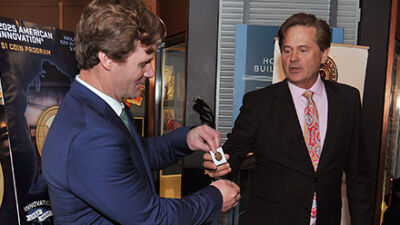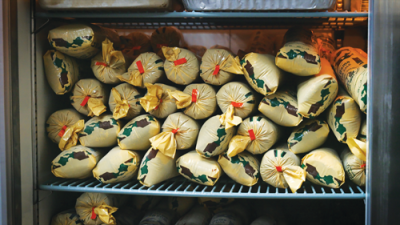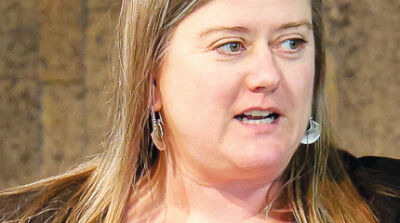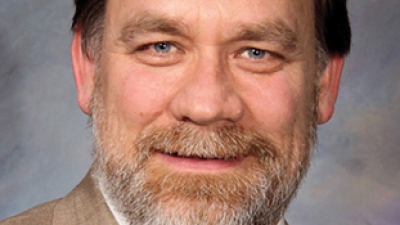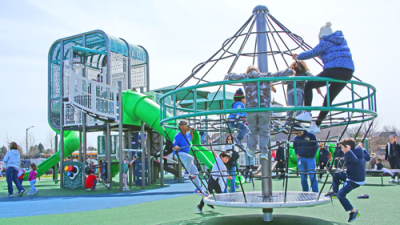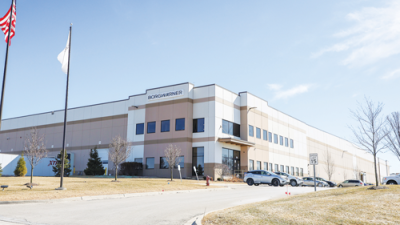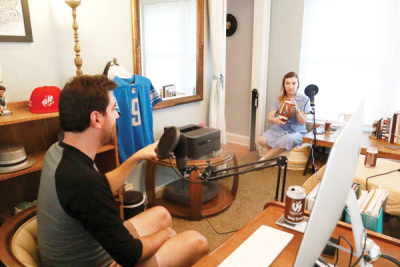
Sam Malott Brown and Brian Moore record a “Forming Function” podcast episode Sept. 17 on the design behind footballs.
Photo by Erin Sanchez
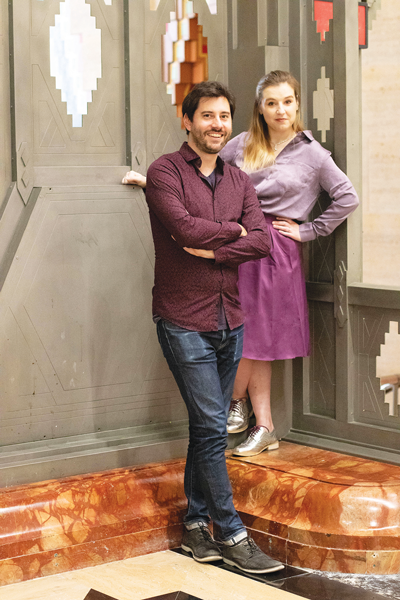
Moore and Malott Brown delve into the why behind design with their Detroit-based podcast, “Forming Function.”
Photo by Lindsay Hansmann
METRO DETROIT — “Forming Function” is “a design podcast for everyone.”
On the Detroit-based podcast, co-hosts Brian Moore and Sam Malott Brown cover everything from barber poles to Prince to toilets. Pairing history with architecture, the duo set out to uncover the origins and meaning behind everyday design in each episode using Moore’s background as an architect and Malott Brown’s education in anthropology and historic preservation, which is only fitting considering that the pair met while working at an architectural firm in Detroit.
The podcasters share a charisma and curiosity that allows for easy listening as they delve into their biweekly design fascination.
“I have a running Google sheet that I’m just continuously adding ideas to every time I’m out in the world, and I’m like, ‘Wonder what that’s about. Let’s add it to the list,’” Moore said.
“I feel like I come at it almost from a backward perspective of Brian, where he’s like, ‘OK, here’s the problem. What is the design solution that can resolve that issue?’ Whereas I’m like, ‘Oh, here’s the solution that they came up with. What was this used for? What was the problem?’” Malott Brown said.
Moore explained that he had wanted to do a podcast since 2015, but nothing came to fruition until COVID-19 hit and he was hosting a “quarantined lawn happy hour” at his house.
“I don’t even remember how the topic came up, but I started talking about how I wanted to do this. I actually think someone brought up barber poles at the happy hour. I was like, ‘Oh, I’ve been wanting to do a podcast episode about this.’ Sam’s husband, Jeff, said, ‘Oh, well, Sam’s been wanting to do a design podcast too. You guys should do something together,’” Moore said.
“Jeff kind of pawned me off on Brian,” Malott Brown joked.
She explained that at one point, she tried to convince her husband to do a podcast with her because she wanted to do something creative during the pandemic.
After discussing the plan for about a year, Moore and Malott Brown picked a name and secured the Michigan Architectural Foundation’s Damian Farrell Architectural Awareness grant. The grant provides “financial assistance to organizations and individuals that organize, sponsor and promote events, lectures, publications and experiences that increase awareness of architecture.”
In 2024, the MAF Damian Farrell Architecture Awareness Grants Committee and the MAF Board of Trustees approved a total of $15,000 to be awarded to architectural awareness efforts like the Forming Function podcast. Moore and Malott Brown did not disclose the amount of the grant since it is a competitive application process. They explained that they were not profiting from the grant and that it helped them purchase equipment to streamline the editing process. Under the grant agreement, they did eight episodes in the first season and agreed to do 12 episodes this season.
“One of the requirements we made with them on the funding was that every season we would have at least one episode about Michigan architecture. And so, in the first season, we had an episode about the GM Tech Center. This season, we’ll have Northland Shopping Center, which is a very significant work that contributed to architectural movements across the country as a whole,” Moore said.
In April 2023, Moore and Malott Brown launched their first episode, “What’s White and Red All Over?” which focused on the gruesome history of barber poles. Moore said that becoming a podcaster made him adjust to explaining topics in more detail.
“I was giving someone a preview of the story. I talked about bloodletting and moved on. And they were like, ‘Whoa, wait. What’s, what is bloodletting?’ I just assumed people knew what this was. So I went and rewrote my whole story, and there’s now a 10-minute segment about what that is and why they did it. And that actually became kind of the crux of the story.” he said.
Malott Brown explained her process for storytelling on the podcast.
“If the structure is always the same, it gets a little bit stale. So, trying to figure out how to tell the same story in a way that people will get something out of it, but in maybe new ways, with different perspectives and different angles, that keeps it fresh,” she said.
Lindsay Hansmann is a former coworker turned friend of Moore and Malott Brown. Hansmann has done photography for the podcast and appeared in the second episode of season two, “Potty Language,” which discusses the history of toilets and the evolution of sanitation systems.
Hansmann remembered when they asked her to do the episode.
“I was very honored. I showed up to record, and I was telling Brian how nervous I was,” Hansmann said.
Hansmann said that Moore reassured her.
“What I didn’t say out loud back to him, but what I thought was, ‘No, I’m nervous that it’s just not going to be as good as when it’s you two.’ Because they just have such a great flow. Thankfully, they are exactly who they are. And he was correct. Within a few minutes, we were talking like we would if we were out to grab a bite.”
In addition to Hansmann’s appearance in episode two of season two, listeners can look forward to topics such as the designs behind footballs, tarot cards, witches and Northland Mall. Malott Brown encouraged listeners to share their curiosities with them at formingfunctionpodcast@gmail.com.
“We do like to answer people’s questions,” she said. “So, if there’s anything that people are curious about, we definitely want them to send that to us so that we can answer those questions. Because we’re only two people, our curiosity can only expand so far. So, if there is anything that people are wondering about, we definitely want to help satisfy that for them.”
Where to find Forming Function:
Forming Function can be streamed on “any podcasting platform,” including Spotify, Apple, iHeartPodcast Network, Castbox and more. For more information on the Forming Function podcast, visit its Facebook page at facebook.com/FormingFunctionPodcast or check out their Instagram, @formingfunctionpodcast.
 Publication select ▼
Publication select ▼


